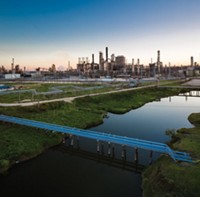Advertisement
Grab your lab coat. Let's get started
Welcome!
Welcome!
Create an account below to get 6 C&EN articles per month, receive newsletters and more - all free.
It seems this is your first time logging in online. Please enter the following information to continue.
As an ACS member you automatically get access to this site. All we need is few more details to create your reading experience.
Not you? Sign in with a different account.
Not you? Sign in with a different account.
ERROR 1
ERROR 1
ERROR 2
ERROR 2
ERROR 2
ERROR 2
ERROR 2
Password and Confirm password must match.
If you have an ACS member number, please enter it here so we can link this account to your membership. (optional)
ERROR 2
ACS values your privacy. By submitting your information, you are gaining access to C&EN and subscribing to our weekly newsletter. We use the information you provide to make your reading experience better, and we will never sell your data to third party members.
Petrochemicals
Big petrochemical project may come to the Gulf Coast
Engineering firm KBR says it has signed a contract for a large new plant
by Alexander H. Tullo
March 31, 2022

The US Gulf Coast may be getting a massive new petrochemical complex.
The engineering firm KBR says it has signed an agreement to license its catalytic olefin and steam cracking technologies to an unnamed “leading midstream company” that will use them to build a large facility.
Midstream companies provide services to the oil, gas, and petrochemical industries like operating pipelines, terminals, and storage facilities. They also fractionate chemical feedstocks such as ethane from natural gas streams. Most don’t involve themselves directly in chemical production.
KBR, one of the world’s largest petrochemical technology providers, says the facility will have 2.4 million metric tons (t) per year of light olefin capacity. That could make it larger than Dow’s new ethylene cracker in Freeport, Texas, which weighs in at 2 million t of capacity after a recent expansion and is billed as the largest facility of its kind in the world.
KBR’s K-COT catalytic olefin technology, which the company first put into commercial operation in 2006, adds another twist to the project. According to a recent KBR presentation, K-COT is a fluidized catalytic cracking process—similar to that found in an oil refinery—and uses a modified ZSM-5 catalyst. The process typically takes in hydrocarbon feedstocks with between 4 and 10 carbons and turns out products such as ethylene, propylene, and aromatics.
“The yields are dramatically different depending on the mix of feeds,” says Steve Lewandowski, vice president of olefins for the research firm IHS Markit. He notes, for instance, that the ratio of propylene to ethylene can range from 2:1 to 1:1. A typical refinery fluidized catalytic cracker emphasizes propylene, while an ethylene cracker overwhelmingly produces ethylene.
A few midstream firms have the financial heft and inclination to take on such a sizable petrochemical project, Lewandowski says. One is Enterprise Products Partners, which operates an ethylene pipeline and storage system on the Gulf Coast. Enterprise completed a propane dehydrogenation facility in Mont Belvieu, Texas, in 2018, and is planning another such unit for 2023. Another candidate is Energy Transfer Partners, which operates a pipeline system that takes ethane from Western Pennsylvania to a marine terminal near Philadelphia and to Ontario.
KBR’s announcement didn’t mention making olefin derivatives such as polyethylene or polypropylene. Lewandowski says it is likely that chemical industry partners would sign agreements to take output from the facility, as they have done for other olefin projects. For instance, LyondellBasell Industries agreed to take some of the propylene from Enterprise’s new dehydrogenation plant.





Join the conversation
Contact the reporter
Submit a Letter to the Editor for publication
Engage with us on Twitter